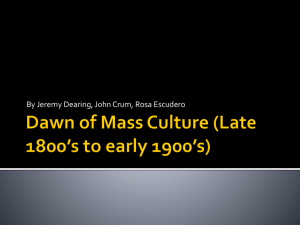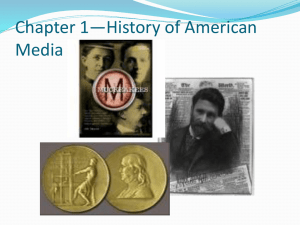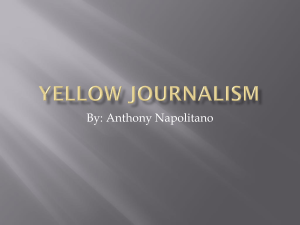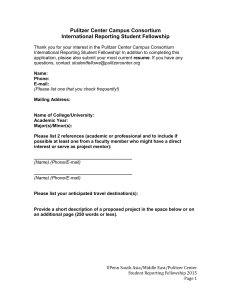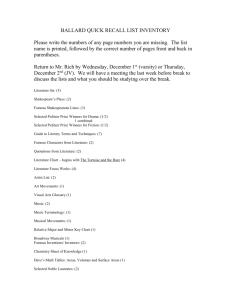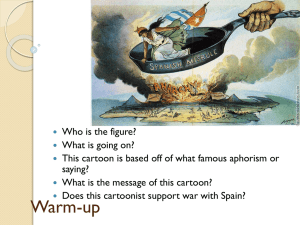Part 3 - Ector County Independent School District
advertisement
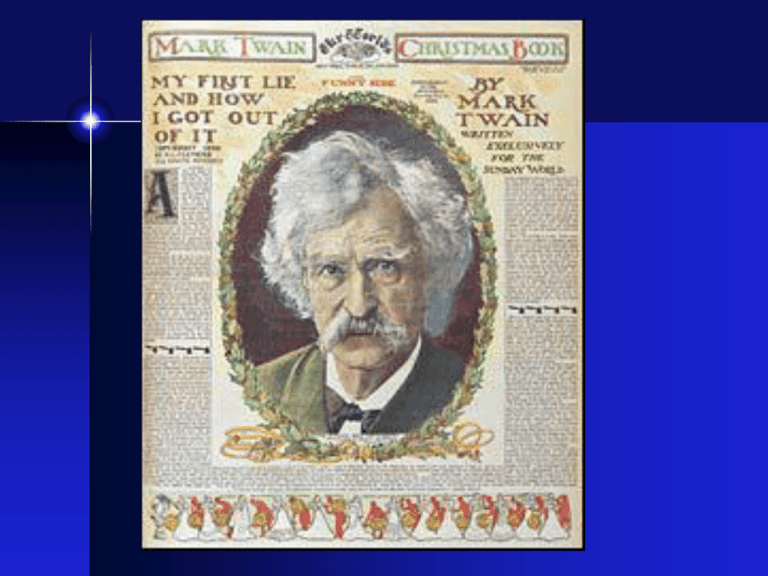
Yellow Journalism When objectivity took a seat. Yellow Journalism • Biased opinion masquerading as objective fact. • Sensationalism • Distorted stories • Misleading images for the sole purpose of boosting sales and exciting public opinion2 Yellow Journalism • Industrial Revolution began at this time • Machines made it easy to print thousands of papers in a single night • Endless drive for circulation • Often the publisher’s greed was placed before ethics2 The Age of Pulitzer and Hearst • Time period of Yellow Journalism was said to be from 1880-18902, although it lasted clear into the 1930s. • The term was first coined based on a series of occurrences in and following the year 18952 Joseph Pulitzer • Came to the US from Budapest in 1864 at the age of 17 • Joined the Union Army and fought in the Civil War1 Joseph Pulitzer • 1878- he bought the St. Louis Post-Dispatch and combined it with the Westliche Post, a paper that he part-owned1 • He used the Dispatch to launch crusades against government corruption, lotteries, gambling and tax fraud7 Joseph Pulitzer • 1883- he buys the New York World for $346,000 • The paper had been losing $40,000 a year7 • His opening statement: • “There is room in this great and growing city for a journal that is not only cheap but bright, not only bright but large, not only large but truly democratic -- dedicated to the cause of the people rather than that of the purse potentates -- devoted more to the news of the New than the Old World -- that will expose all fraud and sham, fight all public evils and abuses -- that will battle for the people with earnest sincerity1 Joseph Pulitzer • A year later, sales boomed to 100,000 • In celebration, he had 100 guns fired off in the City Hall park and gave each employee a tall silk hat1 Joseph Pulitzer • The World was known for its editorial page -- income tax, shorter working hours and restrictions on monopolies • It became the country’s leading champion of liberals1 • Overtones of sensationalism -- Subjectivity -- woven around a substantial core of real news1 Nellie Bly • Her actual name was Elizabeth Cochrane, but changed it because women found it hard to be taken seriously in the journalism world, and so did not get high-paying jobs • Joined the New York World in 1887 Nellie Bly • Wrote investigative articles over poverty, housing and labor conditions in New York • Feigned being insane and sent to Blackwell’s Island, the New York insane asylum • Wrote a book titled Ten Days in a Mad House (1888) http://www.spartacus.schoolnet.co.uk/USAWbly.htm Nellie Bly • After reading the Jules Verne novel Around the World in 80 Days, Pulitzer thought it would be a good day to see if the book was right. • Sent Bly to break the 80 day record and held a contest with readers of the New York World to guess when she would return Nellie Bly • Over 1,000,000 people entered the contest • She arrived to a large crowd with a time of • 72 Days, 6 hours, 11 minutes and 14 seconds William Randolph Hearst • Attended Harvard • Business manager of a humor magazine, the Lampoon. • He gave parties causing difficulties with school authorities • He finally left Harvard by request1 William Randolph Hearst • Father accepts the San Francisco Examiner as payment for a gambling debt and gives it to William in 18876 • Hearst brings writers such as Ambrose Bierce, Stephen Crane, Mark Twain, Richard Harding Davis and Jack London with him • They bring crusades, scoops, and sensational stories to San Francisco1 Pulitzer vs. Hearst • Hearst came to New York and bought the New York Journal in 1895 for 7.5 million from Pulitzer’s brother1 • Pulitzer didn’t even know it had been for sale Pulitzer vs. Hearst • Hearst wanted to have a bigger circulation than the World, which was 400,000 at the time • He bought Pulitzer’s writers away for high salaries, as well as his cartoonist Robert Outcault, artist of the famous “The Yellow Kid” • Within 12 months the Journal had overtaken the World1 Pulitzer vs. Hearst • To be fair, Pulitzer had originally stolen many of his staff members from other papers when he came to New York5 • Pulitzer hired more writers as well as another cartoonist, George B. Luks, to continue “The Yellow Kid” is his newspaper • So both the Journal and the World carried the same strip, with different cartoonists The Yellow Kid • The term Yellow Journalism is derived from this cartoon • The strip used a special, non-smear yellow ink • The kid’s jacket was always yellow The Yellow Kid • 1st merchandising phenomenon of the comics • Key chains, collector cards, appeared on stage, and even had a magazine named after him for a short time • Often used to sensationalize stories and discredit the stories of other papers • Also used to sway public opinion on important issues such as the SpanishAmerican War4 The Spanish-American War This war is brought to you in part by . . . Spanish-American War • Evangelina Cisneros- niece of the president of the insurrectionist Cuban government • She is imprisoned in Havana • Hearst begins crusade to get her freed • Evangelina is then rescued from prison by Karl Decker, according to the Journal • Decker was a reporter sent to Havana for that purpose, according to the Journal1 Spanish-American War • News was slow • Hearst illustrator Frederic Remington in Havana requested to come home, stating that nothing was happening • Hearst supposedly sent a telegraph stating: • “Please remain. You furnish the pictures and I’ll furnish the war.”6 USS Maine • Battleship explodes and sinks off the coast of Havana • Many papers counseled patience and peace • The Journal and the World concurrently published a “suppressed cable” that said the explosion was no accident, which was later discovered to be manufactured5 Spanish-American War • Hearst demonstrated his love for glory over objectivity by leading a force of writers, photographers and artists to the scene of action in Cuban waters with a small fleet of steamships • His reporters were stationed with every important military unit1 Spanish-American War • Journal circulation reached 1.5 million during the war, and the World was right behind them1 Journal vs. World • Hearst tricked Pulitzer when he ran a story in 1898 describing the death of Colonel Reflipe W. Thenuz5 Journal vs. World • The next day the World carried the story, adding specific dateline information to make the story more authentic.5 Journal vs. World • Colonel Reflipe W. Thenuz • “We pilfer (steal) the news.”5 Journal vs. World • The Journal celebrated for a month as the World maintained a “pained silence” on the blunder5 Regrets • Pulitzer regretted the actions he had taken • When gold began to lead to an outbreak in hostilities between Venezuela and British Guiana, Pulitzer jumped in • Pulitzer had his writers write balanced accounts of the story, against the popular opinion and President Cleveland’s denouncing British policy5 Regrets • In one editorial: • “Is the integrity of Venezuela’s ‘essential to the integrity of our free institutions?’ . . . There is no menace to the boundary line. It is not our frontier. It is none of our business.” • The words had come directly from the president5 • Feelings toward this calmed, and later resolved by the British Due to inaccurate reporting and the distortion of the truth to appeal to emotions, it is unsure what the true history of this time period could have been1 The general public frowned upon subjective practices after a while. By 1910, circulation had dropped off very rapidly for such papers Newsmen and women at competing papers were amused when Hearst issued a bulletin in 1933 that established editorial guidelines for his newsrooms across the country6 Pulitzer-After • Died in 1911 • Donated in will $2 million for a journalism school at Columbia University • Left funds to establish annual prizes for literature, drama, music, and journalism • 1922-cartoonists were added to the prizes • Known as the Pulitzer Prize Pulitzer Prize Pulitzer Prize Hearst-After • US Representative from 1903-07 • 1920s-built a castle on a 240,000 acre ranch at San Simeon, CA. • At his peak he owned 28 major newspapers and 18 magazines, along with several radio stations and movie companies6 Hearst Castle Citizen Cane • By Orson Welles • Said to be based on Hearst’s life • Hearst tries to shut down the film, burning negatives and having people intimidate exhibitors into refusing to show the film It can not happen again • People are smarter • People keep an eye on the media • They are not as easily trusted as they once were It can happen again • Although they can, most often pay less and less attention to news • Therefore, the media has to get more creative • Rely more on opinionated reporting and commentary to strike interests Do not let the media get the opportunity to go ‘Yellow’ again
